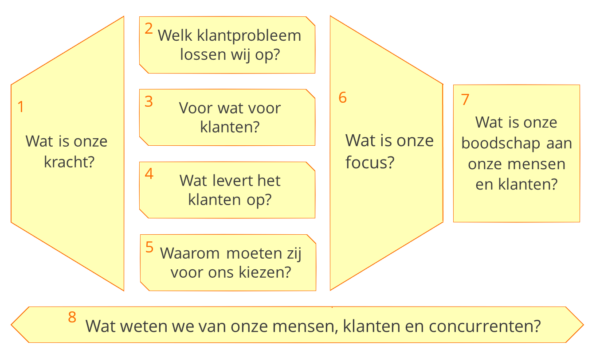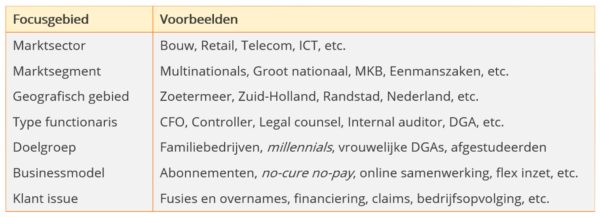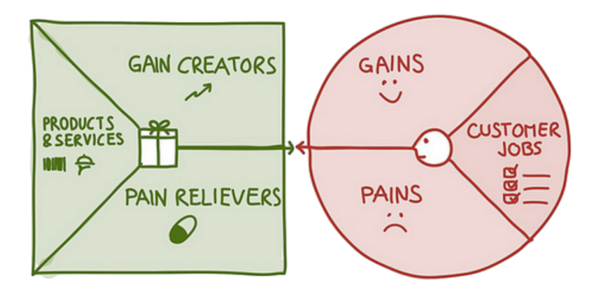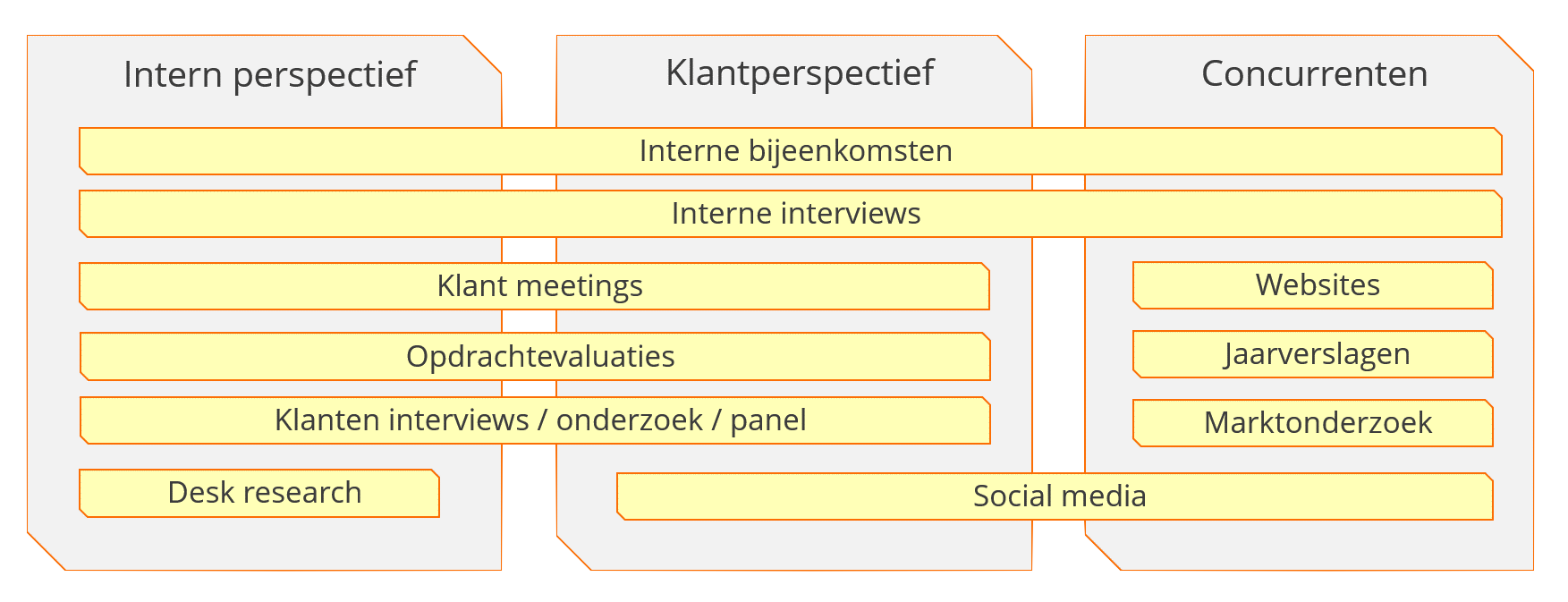A strong proposition for better results - 8 questions for accountants, consultants and lawyers

Commercial actions without a clear proposition is like selling products with illegible packaging: it is not impossible, but it is very difficult. And if it succeeds, there is a good chance that the content of the packaging is not what the customer was looking for, after which he will still drop out.
What is a proposition?
A proposition summarizes what you can do for a customer and why he or she should choose your office for that. So not exactly a detail! The clearer the proposition, the more likely you are to reach the right customers. And the stronger the proposition, the more customers you attract and retain. Therefore, the proposition is central to the first pillar below it commercial result of accountants, consultants and lawyers.
The concept of propositions applies to all sectors, but in this blog I focus on accountants, consultancy firms and law firms. Business service providers in particular often find it difficult to arrive at a clear proposition. For example, because it is difficult to make choices and they are not used to thinking in propositions.
Relationship management is the third pillar of the commercial result of accountants, advisers and lawyers. Click here for more on these pillars.
How do you arrive at a good proposition?
To determine a strong, clear proposition, you only need to answer 8 questions. This lays the foundation for commercial activities that lead to more results.

1 What is our strength?
In marketing, "thinking from the outside in" is sacred. The starting point is always what is going on in the market and what is on the agenda of (potential) customers. And that is quite right! Perhaps it is precisely in sectors such as accountancy and the legal profession that there is a great tendency to approach everything from your own field and to deal with the internal organization a lot.
First I had to get used to the term “inside-out marketing”, which I was frequently confronted with in my international role at EY. At first I felt resistance. But if you think about it longer, it actually makes sense that - in addition to outside-in - an inside-out approach is also necessary to be successful.
A business service provider's capital essentially consists of only two things: the brand and the people. And these people in turn represent expertise, relationships and organizational culture - the office's DNA.
Brands and reputations are deeply embedded in people's minds; changing it is difficult and time consuming. The same goes for the people; they are jointly the organization. And those same people are the crux of the commercial initiatives with which an accountancy, consultancy or law firm wants to strengthen the commercial result.
It is therefore important to choose a proposition that capitalizes on the current brand, reputation, relationships, expertise and culture of the organization. Hence “inside-out marketing”. In other words, the proposition must be supported internally, only then is it externally effective and credible, and can it be successfully supported and fulfilled internally. So “Living the brand”.
2 Which customer problem do we solve?
Then, of course, it remains crucial to link that own strength to what lives with the target group. As logical as this may sound, in my work with partners and fee earners I have noticed that this can be difficult:
In the first place, the professional must be able to translate his own specialism and jargon into issues and the language of the customer. Secondly, the professional must be able to listen and think outside of his own specialism. Take, for example, a construction company that has delay risks high on its agenda. The lawyer may think of liability, while the tax advisor sees fiscal consequences and the organization advisor is alert to logistical risks.
To really think from the customer's perspective, the professional must therefore rise above his specialty, something that not everyone is naturally given. At the large offices, both roles and profiles are often translated into client partners versus engagement partners.

When determining the proposition, it is important to start from the issues on the agenda of potential customers, without immediately filtering from your own expertise and services.
There are several ways to find out about these issues. Of course by talking to your own people who work, or have experiences, in the relevant sector. But also, for example, by following social media posts from target organizations (and their people). See question 8 for more information sources.
Ideally, based on these sources, you determine a top 10 of issues that affect the relevant customers and then select those issues in which you can offer optimal added value. Also formulate that added value in terms that the target group itself uses.
3 For what kind of customers?
It is important to define sharply for which type of customers the found own strength and customer issues are most relevant. The better this match, the more powerful the proposition.
You can define customer target groups in different ways. This can be a sector, but also a type of officer or customer issue. The diagram below shows some examples of possible focus areas.

Fortunately, it is usually not necessary, or even wise, to choose one focus area. A unique proposition often arises from a combination of focus areas. For example: “Assisting medium-sized Dutch family businesses in takeovers”.
4 What are the benefits for the customer?
If it is clear what problem you solve for which type of customer, the next question is: what results does the customer achieve by calling on us?
Describe these results in terms that match customers' problems and goals. Is it about time savings? Cost reduction? Innovation? Risk management? Alternative financing? More turnover? Profit? Clarity? Different?
Value proposition
In this context, the value proposition is often discussed. In essence, the value of the customer can only be two things: it solves a problem, or it helps to achieve an objective. In the Value Proposition Designer Canvas these are called 'Pain relievers' and 'Gain creators' by Alexander Osterwalder.

5 Why should they choose us?
When it is clear what kind of customers are helped with which issues to solve their problems or achieve goals, the next question is: why us?
This brings us to a much discussed topic: positioning.
Positioning
The aim of positioning is to have a distinctive position among target groups as a brand compared to competitors.
This is also a popular subject within accountancy firms, consultancy firms and law firms. We all want to be “different” and “distinctive”.
Not surprising, because an organization that knows how to distinguish itself positively is more often invited to offer, every offer process starts with a head start and is not affected by price competition. Conversely, if you are “only” one of the firms with the expertise you need, you will be irrevocably faced with price competition and thus a downward “race to the bottom”.
Distinctiveness
Hinge Marketing has investigated the positioning of a large number of business service providers. This shows that many offices use a 'differentiator' that sounds logical but will not work. They often claim their distinctive character in one of the following areas:
- Our people are better;
- Our approach is better;
- We aim for top quality;
- We offer more service;
- We are different.
These claims are not distinctive, just a precondition, cliché, hard to make or meaningless. That's why they don't work. Click here to learn more about these 5 positioning strategies and why they don't work.
Distinction that can work meets 2 criteria:
- True: the claim is based on matters in which the organization actually distinguishes itself or can start to distinguish it;
- Relevant: the claim relates to something that is considered important by (potential) customers.
There are essentially two ways to arrive at a distinctive positioning: by identifying a distinction and then putting it at the center of the further approach, or by choosing distinction on the basis of market needs and then giving substance to this.
An example of the latter is the introduction of 'Building a better working world' by EY. When EY introduced this purpose, its substantiation largely applied to competitors. However, what matters next is that the organization develops initiatives so that the distinction is also demonstrable. That is exactly what EY is doing now.
6 What is our focus?
After going through the first 5 questions, there is usually a range of customer questions, target groups and customer values on the table.
Focus, focus, focus, is the motto. But the question that precedes it is: why choose?
After all, choosing means 'fishing from a smaller pond'. This question is of particular concern to business service providers, as they often have people who have common knowledge of many sectors and specialties. As a result, choosing quickly meets resistance, as there are always partners and employees who find that their specialization does not match the proposed focus!

By focusing sharply as an office, you more often get customers and assignments that suit you well and where you can achieve a higher margin. After all, if you know everything about the market and problems of the customer and have carried out similar assignments at similar organizations, you do not have to invent wheels and you can provide added value throughout the entire process. Organizations do not like to do business with offices that know something about everything, but excel in nothing. This translates into lower rates for offices with an unclear proposition.
This 'matching' principle works both ways: not only are you more successful in acquiring new customers and assignments with a clear focus, you will also be approached much faster by customers who suit you! After all, by consistently doing those things that fit seamlessly with your proposition, non-customers will also recognize what you can do for them. While potential customers are unlikely to approach you at all with an unclear proposition and - if they do - chances are that they will choose a competitor after a time-consuming and costly acquisition process.
7 What is the message to our people and customers?
Once all previous questions have been answered and a clear focus has been determined, it is important to ensure that the proposition is actually realized and propagated.
For many companies, this is primarily a task for the marketing department, but for business service providers all partners and employees play a crucial role here. After all, they are the ones who have daily contact with numerous customers and prospects, so the extent to which they understand, support and propagate the proposition is crucial.
If all goes well, various partners and employees are involved in answering the previous proposition questions. This helps to ensure that the proposition is understood and supported. In most cases, however, not everyone has been involved in the process and new employees are also joining. It is therefore important to put the proposition clearly on paper and to discuss it internally, for example during team meetings.
In addition, the proposition must be incorporated in all kinds of marketing and communication materials. Think not only of the website, but also, for example, of slides for presentations, quotations and materials for customer meetings.
The following formula can be used as a starting point for formulating a proposition:
We help [description target customers] that deal with [description customer problem or objective] to achieve [description what your approach for customers yields] by [describe what distinguishes (the approach of) you].
As an example, let me Flex Professionals take the proposition of 4Future. This can be summarized as follows:
We help accountancy firms, consultancy firms and law firms that want to improve their commercial approach, but do not have sufficient expertise or capacity, to affordably improve the result with flexibly deployed, experienced marketing and business development professionals.
Multiple propositions
In most cases, an organization has a number of propositions. The proposition at brand level is usually quite broad and generic, while there are more specific propositions at the level of, for example, specialties and services. It is of course important that the propositions at the level of specialisms or services are logically related to the brand proposition.
8 What do we know about our customers and competitors?
The last question actually runs like a thread through the answers to all previous questions. It is important to use different sources to get good input from your own people, customers and competitors.
It is often tempting to base information about what customers think and want on input from their own people. That is also valuable, but only if there is also direct input from customers. This can of course be done with a survey, but there are various other ways to gain and keep track of what customers find relatively easily. A very important one that is often forgotten are meetings with customers that already take place. Why not use these conversations immediately to ask the customer a number of questions?

By regularly testing the proposition, for example in customer conversations, a feedback loop is created that ensures that the proposition increasingly matches what customers are looking for.
Finally
Determining the proposition does not have to be difficult. It is also not necessary to get it completely perfect in one go. The most important thing is that before you start all kinds of commercial actions, you consider what exactly you have to offer for whom. This greatly increases the chance of success.
Would you like to discuss your propositions? Let me know, I like to think along!

